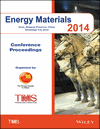Corrosion of Advanced Steels: Challenges in the Oil and Gas Industry
Brajendra Mishra
Professor & Co-Director
NSF Center for Resource, Recovery & Recycling, Metallurgical & Materials Engineering, Colorado School of Mines, Golden, CO, USA
Search for more papers by this authorDiran Apelian
Alcoa-Howmet Professor & Director
NSF Center for Resource, Recovery & Recycling, Metals Processing Institute, Worcester Polytechnic Institute, Worcester, MA, USA
Search for more papers by this authorBrajendra Mishra
Professor & Co-Director
NSF Center for Resource, Recovery & Recycling, Metallurgical & Materials Engineering, Colorado School of Mines, Golden, CO, USA
Search for more papers by this authorDiran Apelian
Alcoa-Howmet Professor & Director
NSF Center for Resource, Recovery & Recycling, Metals Processing Institute, Worcester Polytechnic Institute, Worcester, MA, USA
Search for more papers by this authorThe Minerals, Metals & Materials Society
Search for more papers by this authorThe Minerals, Metals & Materials Society
Search for more papers by this authorSummary
This chapter contains sections titled:
-
Introduction
-
MIC Causative Microorganisms
-
Biofilm Developmental Stages and Implications
-
Detection and Diagnostic Methodologies of MIC
-
Mitigation and Treatment of MIC
-
Summary
References
- F. M. AlAbbas et al., “Bacterial Attachment To Metal Substrate and Its Effects on Microbiologically-Influenced Corrosion In Transporting Hydrocarbon Pipelines,” Journal of Pipeline Engineering, 11 (1) (2012), 63–72.
-
Brenda Little and Jason Lee, Microbiologically Influenced Corrosion (Hoboken, NJ: John Wiley & Sons, 2007), 272.
10.1002/047011245X Google Scholar
- Reza Javaherdashti, Microbiologically Influenced Corrosion: An Engineering Insight (Springer-Verlag London, UK: 2008), 172.
- AlAbbas, Faisal M., et al., “ Corrosion of Linepipe Carbon Steel (API 5l X52) Influenced by A SRB Consortium Isolated From A Sour Oil Well”, Corrosion (2013), Paper # 2275, NACE
- W.A. Hamilton, “Sulfate-Reducing Bacteria and Anaerobic Corrosion”, Annual Review of Microbiology, 39 (1985), 195–217.
- K.H. Nealson and D. Saffarini, “Iron and Manganese in Anaerobic Respiration: Environmental Significance, Physiology, and Regulation”, Annual Review of Microbiology, 48 (1) (1994), 311–343.
- L.K. Herrera and H.A. Videla, “Role of Iron-Reducing Bacteria in Corrosion and Protection of Carbon Steel”, International Biodeterioration & Biodegradation, 63 (7) (2009), 891–895.
- H.A. Videla and L.K. Herrera, “Understanding Microbial Inhibition of Corrosion. A Comprehensive Overview”, International Biodeterioration & Biodegradation, 63 (7) (209), 896–900.
- A. Jayaraman, J. Earthman and T. Wood, “Corrosion Inhibition By Aerobic Biofilms On SAE 1018 Steel”, Applied microbiology and biotechnology, 47 (1) (1997), 62–68.
- H.A. Videla, Corrosion Inhibition by Bacteria. In: Manual of Biocorrosion (CRC Lewis Publishers, Boca Raton, Florida: 1996), 121–135.
- M. Dubiel et al., “Microbial Iron Respiration Can Protect Steel from Corrosion”, Applied and environmental microbiology, 68 (3) (2002), 1440–1445.
- B. Little, P. Wagner, Patricia and F. Mansfeld, “An Overview of Microbiologically Influenced Corrosion”, Electrochimica acta, 37 (12) (1991), 2194–2185.
- C. Dias and M. Bromel. “Microbially Induced Organic Acid Under deposit Attack in a Gas Pipeline”, Materials Performance, 4 (1990), 53–56.
- S. Wolfgang, “Microbial Mechanisms of Deterioration of Inorganic Substrates - A general Mechanistic Overview”, International Biodeterioration and Biodegradation, 40 (2) (1997), 183–190.
- W. Ghiorse, “Biology of Iron and Manganese Depositing Bacteria”, Annual Reviews in Microbiology, 38 (1) (1984), 515–550.
- A. T. Rajasekar et al., “Biodegradation and Corrosion Behavior of Manganese Oxidizer Bacillus Cereus ACE4 in Diesel Transporting Pipeline”, Corrosion Science 49 (6) (2007), 2694–2710.
- R. Bos, C. Henny and H. Busscher, “Physico-Chemistry of Initial Microbial Adhesive Interactions–Its Mechanisms and Methods for Study”, FEMS Microbiology Reviews, 23(2) (1999): 179–230.
-
Zbigniew Lewandowski and Haluk. Beyenal, Fundamentals of Biofilm Research (CRC Press, 2007), 480.
10.1201/b15996 Google Scholar
- B. Little, J. Lee and R. Ray, “Diagnosing Microbiologically Influenced Corrosion: A State-of-the-Art Review”, Corrosion, 62 (11) (2006), 1006–1017.
- NACE Standard TM0194-2004, “ Field Monitoring of Bacterial Growth in Oil and Gas Systems”, (Houston, TX: NACE, 2004).
- ASTM International Standard D4412-84, “ Standard Test Method for Sulfate-Reducing Bacteria in Water and Water-Formed Deposits”, (West Conshohocken, PA: ASTM, 2002).
- Corinne Whitby and Skovhus L. Torben, Proceedings from the International Symposium on Applied Microbiology and Molecular Biology in Oil Systems (Springer, London, New York, USA, 2009), 63–76.
- AlAbbas, Faisal M., et al., “ Microbial Community Associated With Corrosion Products Collected From Sour Oil Crude and Sea Water Injection Pipelines”, Corrosion (2013) Paper # 2248, NACE.
- D. Pope, “ GRI Field Guide: Microbiologically Influenced Corrosion (MIC): Methods of Detection in the Field” (Chicago, IL: Gas Research Institute, 1990).
-
H.W. Roosmoore, Handbook of Biocide and Preservative Use (Chapman & Hall, 1995), 185–206.
10.1007/978-94-011-1354-0 Google Scholar
- Z. Xiangyang, H. Modi, and J. Kilbane, “ Efficacy and Risks of Nitrate Application for the Mitigation of SRB-Induced Corrosion”, Paper # 06524, Corrosion (2006), NACE.



